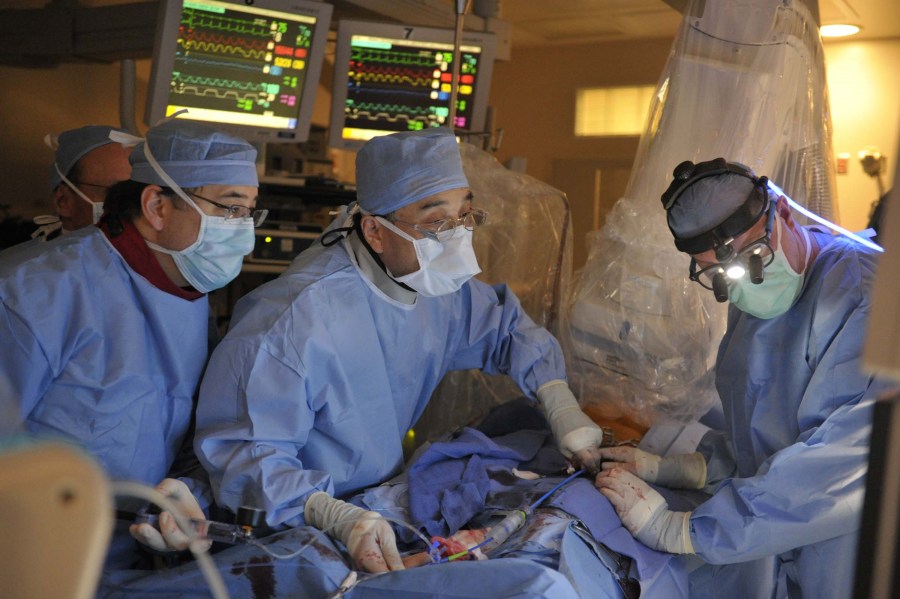
From left, Joseph Fredi, M.D., David Zhao, M.D., and John Byrne, M.D., perform the new trans-catheter aortic valve-replacement procedure in Vanderbilt’s hybrid OR. (Photo by Joe Howell)
Vanderbilt Heart offers new aortic valve technique
Interventional cardiologists and surgeons successfully performed Vanderbilt’s first transcatheter aortic heart valve-replacement (TAVR) with a new FDA-approved percutaneous artificial valve.
On Jan. 5, Vanderbilt physicians used the Edwards SAPIEN Transcatheter Heart Valve, made of bovine tissue, on two patients. Approved in November 2011, this is the first U.S. commercial approval for a transcatheter device enabling aortic valve replacement without the need for open-heart surgery.
Nearly 200,000 people each year are diagnosed with aortic stenosis, a narrowing of the main valve allowing blood to leave the heart. Seventy-five percent of those diagnosed are deemed high risk or ineligible for open-heart surgery — the standard therapy.
Helen Williams, 80, of White Bluff, Tenn., was VUMC’s first recipient of the novel valve replacement technique. The availability of the new valve saved her life when she was deemed too weak to handle standard open heart surgery.
“There are no other options for this group of patients,” said David Zhao, M.D., director of the Cardiovascular Catheterization Lab and Interventional Cardiology.
“With this new procedure, there will be an absolute 20 percent reduction in mortality. This is transformational technology and can potentially save thousands of lives.”
Williams, who underwent the procedure on Thursday, Jan. 5, said she “feared her life would be shortened” when she learned she would need heart surgery.
Instead, she went home within 48 hours of receiving her new valve and is recovering nicely.
The VHVI team is comprised of Zhao, John G. Byrne, M.D., Joseph Fredi, M.D., Mark Robbins, M.D., Marshall Crenshaw, M.D., Steve Ball, M.D., Lisa Mendes, M.D., Mike Baker, M.D., a team of cardiac anesthesiologists and teams from the cath lab and operating rooms.
Vanderbilt began using transcatheter aortic valves in adult patients in July 2011 when it embarked on a clinical trial of Medtronic’s CoreValve. Vanderbilt is one of a few medical centers in the country to offer both the CoreValve and the SAPIEN valve, Zhao said.
In addition, Vanderbilt performs percutaneous pulmonary valve replacements.
Zhao anticipates performing several hundred replacement procedures a year using the newest technology from Edwards SAPIEN.
The valve is made with bovine pericardial tissue and a balloon expandable stainless steel frame. Using transcatheter aortic valve implantation, an artificial aortic heart valve is attached to a wire frame and guided by catheter through the groin to the heart.
Once in place, the wire frame expands, allowing the new aortic valve to open and begin to pump blood.
Compared to the four to six hours typical in open-heart surgeries, this procedure calls for a smaller incision and takes about 90 minutes to complete.
Byrne, William S. Stoney Professor and Chairman of the Department of Cardiac Surgery, said the non-surgical valve replacement technique will become a standard therapy in the next three to five years.
“Vanderbilt is the regional leader in transcatheter aortic valve therapy,” he said.
Byrne attributes the rapid success of the TAVR program to the teamwork, shared vision and goals between Vanderbilt’s cardiologists and cardiac surgeons, established with the opening of the hybrid OR in 2005, which has eased the way for the TAVR program.
“Few centers are able to execute like Vanderbilt because they suffer from the traditional friction that has long existed between these two groups,” Byrne said.













